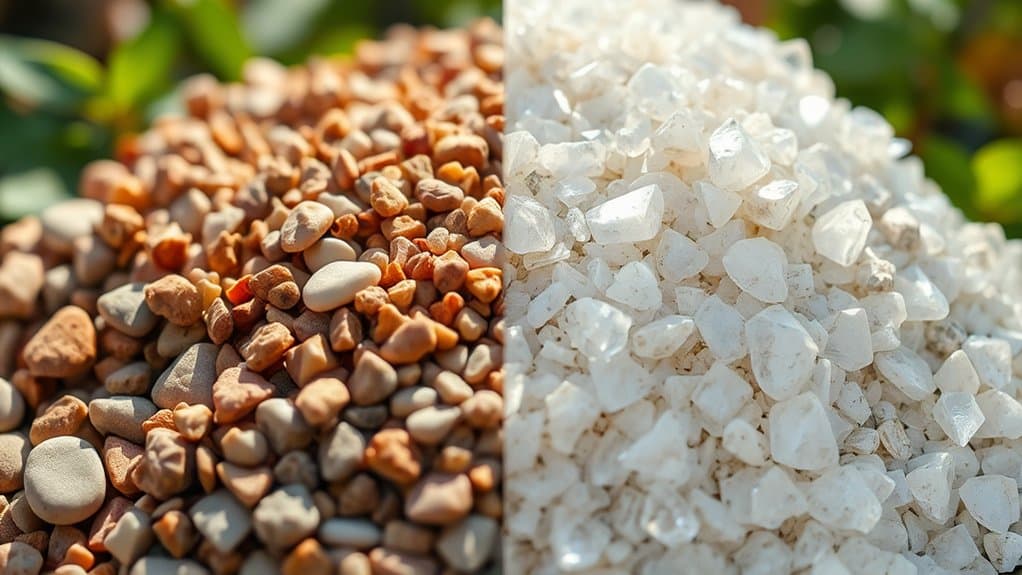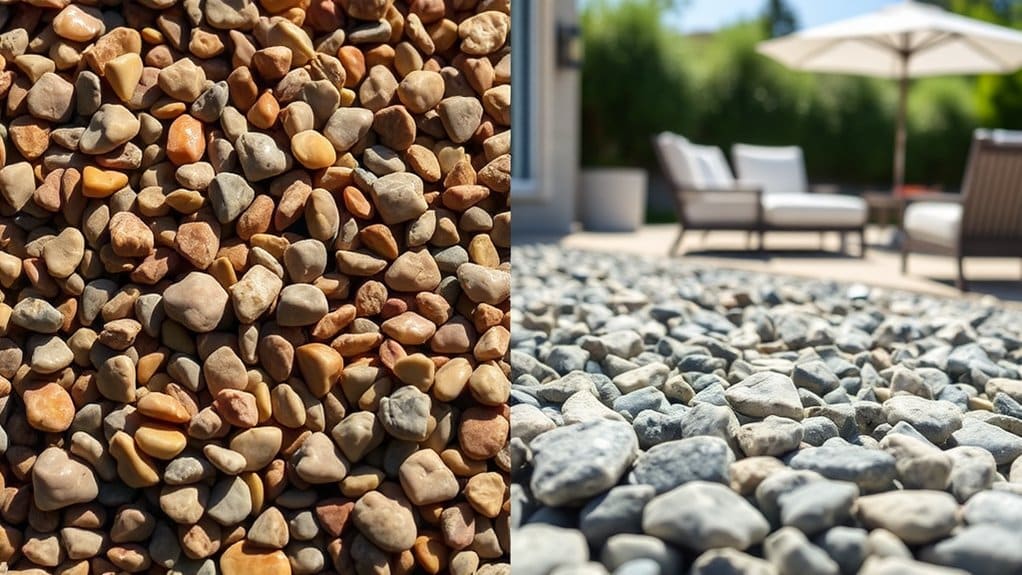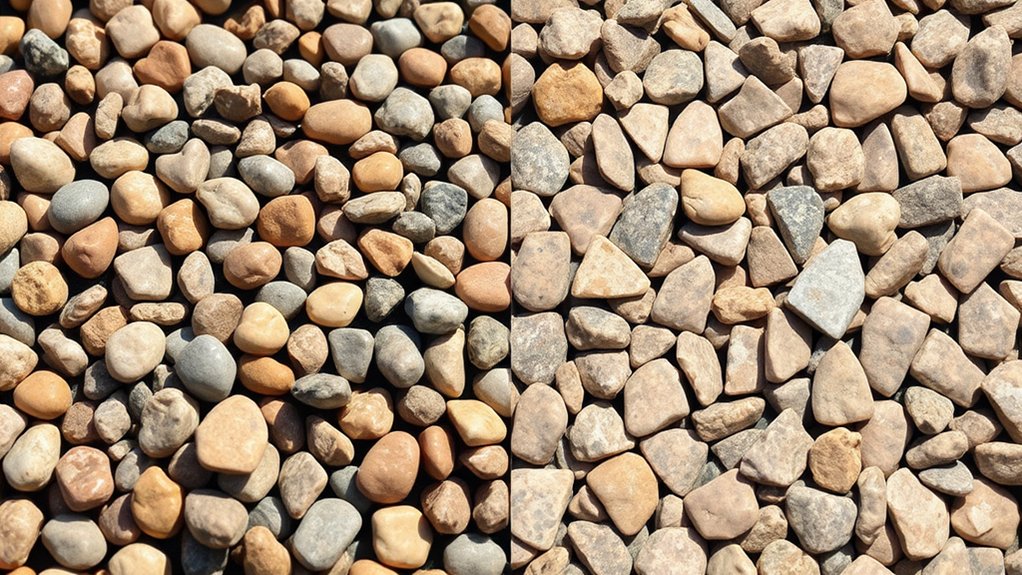Choosing between natural and engineered aggregates for resin-bound gravel comes down to key differences. Natural stones showcase distinct regional colours, from Cotswold buff to Scottish granite, but their irregular grading can make laying trickier. Engineered aggregates offer spot-on consistency in size, better strength, and handle British weather well – think freeze-thaw cycles and heavy rain. They’re often made from recycled materials too, making them a greener choice. Whether you’re doing a driveway in Devon or a garden path in Glasgow, your choice will affect both how it looks and how it performs over time.
Key Takeaways
Natural aggregates feature local colours but suffer from uneven grading, which slows down laying and can affect the final finish.
Engineered aggregates come with exact sizing, making them stronger under weight and better at handling UK winters’ freeze-thaw patterns – they simply last longer.
Look-wise, natural aggregates work brilliantly with country homes and traditional gardens, whilst engineered options give you consistent colours that suit modern properties.
For the environment, quarrying natural aggregates damages local landscapes. Engineered versions often use recycled materials from construction waste, making them the greener choice.
Before laying either type, you’ll need to check your base surface is suitable. Mix the resin properly and watch the weather – installation won’t work in rain or extreme temperatures.
Aggregate Composition

Natural and engineered aggregates differ significantly in resin-bound gravel installations.
Natural aggregates come from quarries or riverbeds, with stones varying in size and shape. These range from 2-5mm (fine) to 10-20mm (coarse) and offer diverse textures, though grading can be inconsistent. Additionally, gravel driveways are easier and quicker to install compared to other options, which can influence the choice of aggregate. Properly graded aggregates provide a tighter fit that enhances the strength and durability of resin-bound surfaces.
However, engineered aggregates are purpose-built, delivering precise particle sizes that lock together more effectively. These often contain recycled materials and meet strict UK building standards.
Your choice between the two affects how well your surface drains, how long it lasts, and how it performs day-to-day.
Think of natural aggregates like randomly packed pebbles on a beach versus engineered ones as precisely cut pieces in a jigsaw – each has its place depending on your project needs.
Aesthetic Options

Aesthetic Options
Resin-bound gravel comes in various aesthetic styles, with the main choice being between natural and engineered aggregates. Natural stones showcase distinctive regional colours that blend well with British landscapes, whilst engineered options deliver consistent shades perfect for modern designs. The finish you choose should complement your property’s look. Additionally, the porous design of resin-bound driveways allows for effective drainage, enhancing their functionality alongside aesthetic appeal. Moreover, custom color mixing can create unique designs tailored to match existing property features, ensuring your surface stands out.
| Aspect | Natural Aggregates | Engineered Aggregates |
|---|---|---|
| Colour Variations | Diverse, regional options | Uniform, customisable colours |
| Textural Options | Smooth to rough textures | Highly tailored textures |
| Visual Appeal | Rustic charm, organic look | Modern sophistication |
| Durability of Colour | May fade over time | Maintains colour integrity |
Your choice of aggregate significantly shapes how your finished surface will look, much like choosing between Yorkshire stone or modern brick for a garden path.
Performance and Durability

Performance and Durability
Key factors affecting your resin-bound gravel’s long-term performance:
- Load Capacity: Engineered aggregates handle weight better than natural ones – ideal for driveways where cars park regularly.
- Weather Resistance: Both types cope well with British weather, though engineered aggregates better withstand our freeze-thaw cycles and heavy rain. Additionally, natural aggregates are often more susceptible to degradation under harsh environmental conditions, which can lead to a shorter lifespan compared to resin surfaces.
- Maintenance Needs: Natural aggregates might need occasional levelling as they settle over time. Engineered options tend to stay put longer.
- Erosion Resistance: Engineered aggregates keep their shape better, much like how properly cut paving stays neat longer than rough stone. This means fewer patches and dips developing.
Environmental Impact

Natural versus engineered aggregates present different environmental impacts in resin-bound gravel systems.
Natural aggregates, whilst traditional, require quarrying that damages landscapes and wildlife habitats.
Engineered alternatives offer a more sustainable choice by incorporating recycled building materials, such as crushed concrete and recovered stone from demolition sites.
Using engineered aggregates helps cut carbon emissions in two ways: it reduces the need for new quarrying and often means shorter transport distances, as recycling facilities are typically closer to urban areas than quarries.
For example, a building project in Manchester could source recycled aggregates locally rather than having natural stone transported from Yorkshire quarries.
The choice is particularly relevant for UK contractors seeking to meet sustainability targets and reduce their carbon footprint.
Engineered aggregates support the country’s growing circular economy whilst preserving our limited natural resources.
Installation and Handling

Installation and Handling
Pre-installation checks and proper handling are vital for resin-bound gravel surfaces. Key points to consider:
- Pre-Installation Preparation: Check for a stable, properly compacted base. Test ground moisture levels – too wet or dry will affect bonding.
- Surface Assessment: Check your existing surface carefully. Man-made aggregates work better on less stable ground, whilst natural stone suits most solid bases.
- Installation Method: Mix your resin and aggregates thoroughly on-site. A proper mix ratio ensures even coverage and correct setting time.
- Aftercare: Keep vehicles and heavy foot traffic off the surface for at least 48 hours. Regular checks help spot any wear patches early on.
Common sense tip: Always factor in British weather – laying resin-bound surfaces in cold or wet conditions can lead to poor results.
Frequently Asked Questions
What Are the Main Uses for Resin-Bound Gravel With Aggregates?
Resin-bound gravel serves as a practical choice for home driveways, garden paths and outdoor spaces across the UK. Its blend of durability and smart looks makes it equally suited to both domestic properties and business premises, from shop fronts to hotel entrances. The surface proves particularly effective in British weather conditions, offering good grip whilst maintaining its appearance year-round.
How Do I Choose Between Natural and Engineered Aggregates?
Consider both costs and appearance when selecting aggregates. Natural options like river gravel and crushed stone offer distinctive character, whilst engineered products such as recycled concrete tend to be more cost-effective over time. For a UK garden path, natural Cotswold stone creates a classic look, whereas engineered aggregates suit industrial or modern builds. Base your choice on your project’s specific requirements and budget constraints.
Can I Mix Natural and Engineered Aggregates?
Natural and engineered aggregates can indeed be mixed, provided proper mixing methods are used. A thorough blend ensures the materials work well together whilst maintaining essential properties. Common combinations include mixing crushed granite with recycled concrete aggregates in construction projects, or blending natural sand with manufactured sand for mortar mixes. Just ensure all materials meet British Standards requirements before mixing.
What Is the Average Lifespan of Resin-Bound Gravel Surfaces?
Resin-bound gravel surfaces last between 15 and 25 years on average, though well-maintained driveways and paths can stretch to 30 years. Much like a good tarmac driveway, proper installation and regular upkeep make all the difference to the surface’s longevity. Professional fitting and occasional jet washing will keep your resin-bound surface in top condition.
How Do Weather Conditions Affect Resin-Bound Gravel Installation?
Weather plays a crucial role in resin-bound gravel installation across the UK. Typical British rain and high moisture levels prevent proper resin curing, whilst extreme temperatures – whether a summer heatwave or winter frost – directly affect how the resin behaves. Much like painting outdoors, choosing the right conditions ensures your surface sets properly and looks spot-on. Best results come from installing on a dry day between 5-25°C.
Conclusion
Choosing between natural and engineered aggregates for resin-bound gravel requires careful consideration of aesthetics, performance and environmental factors. Natural aggregates offer authentic character and local appeal, whilst engineered options provide reliable uniformity and proven durability. Much like selecting building materials for a garden path, each type brings distinct advantages. The right choice depends on your specific project requirements, whether that’s matching a period property’s look or ensuring consistent wear in high-traffic areas.
